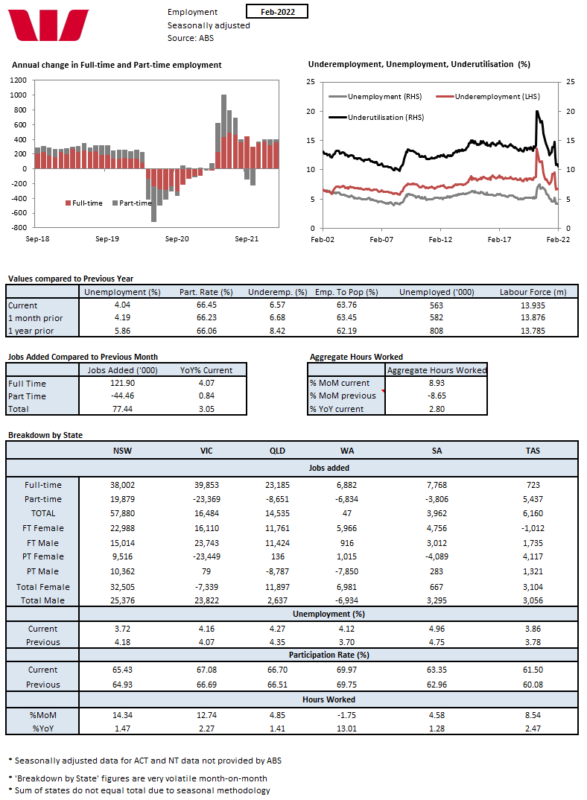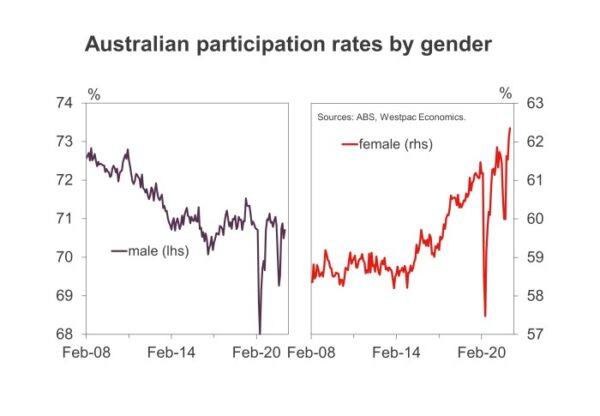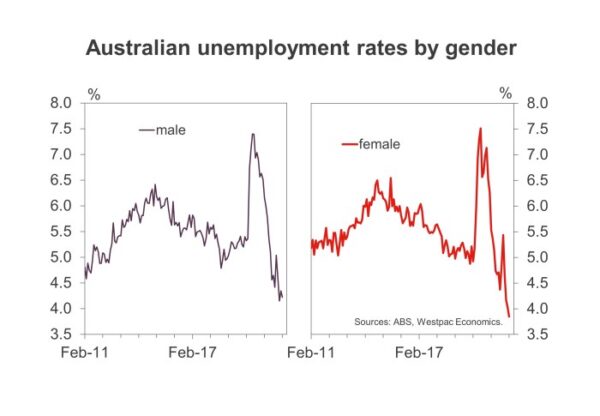Fourth consecutive upward surprise on employment. However, rising labour supply has become dependent on rising female participation. Total employment: 77.4k from 28.3k (revised from 12.9k); unemployment rate: 4% from 4.2% (unrevised 4.2%); participation rate: 66.4% from 66.2% (unrevised 66.2%).
January was the fourth consecutive upside surprise for employment. Employment rose 77.4k, much stronger than the market forecast of +37k and even stronger than Westpac’s top of the range forecast for +60k. This followed on from the 28.3k in January (revised from 12.9k), 70.8k in December and 372.5k in December. There was also the expected strong reversal in hours worked which lifted 8.9% following the Omicron hit of -8.6% in January when an unseasonally high number of people were sick or on leave.
There was even Westpac expected robust rise in participation of 0.2ppt to 66.4% (market was looking for a softer 0.1ppt rise) which drove a 58.9k rise in the labour force. As such, there was a larger than expected fall in the unemployment rate to 4.0% from 4.2% – both the market and Westpac were forecasting an unemployment rate of 4.1%.
February saw the lowest unemployment rate since August 2008 and only the third time in the history of the monthly survey when unemployment was as low as 4.0% per cent (February 2008, August 2008, February 2022). There were lower unemployment rates back in November 1974 but this was when the survey was conducted quarterly.
This is a very robust update on the labour market, not just in terms of robust labour demand but also the strong gains in labour supply with the participation rate hitting a record high of 66.45% at two decimal places.
With the labour demand indictors continuing to paint a very robust picture for the growth in employment, particularly in the near term, with limited growth in the working age population due to the closed borders (up just 0.5% in the year but it is improving with a 0.2.% lift in the last three months) rising 0.8% three months annualised rising participation to new record highs will be critical to providing the required labour to match the demand.
If participation does not rise as expect and the projected employment growth is achieved then we will see a much lower unemployment rate that the 3.8% forecast. It is also possible that if participation does not rise as expected, firms may not be able to attract workers that are suitable to their needs and hence the lack of supply could be brake on stronger employment growth. If this was to happen we could still see the expected 3.8% low in unemployment even with softer than expected growth in employment.
Females have been driving the growth in employment (3.9%yr vs 2.3%yr for males) and the labour force (2.1%yr vs 0.2%yr for males). So even though male unemployment has declined more than females in the year (-1.8ppt to -1.7ppt respectively) it has due to a 0.2ppt decline in male participation in the year. By contrast female participation has lifted 0.95ppt in the year to a new record high of 62.35% – male participation is still higher at 70.71% but it is well off its record high of 79.49% way back in 1978.
It does appear that the recent robust demand for labour has been able to halt the trend decline in male participation but it has not been enough to lift it. Given that, if we are to get the supply of labour needed this year than female participation is going to have to continue to rise to new record highs; our estimate is that it is likely to have to rise to more than 65.50% sometime around mid-year.
It is also worth noting that female unemployment, at 3.8%, is lower than male unemployment at 4.2%. For females, 3.8% is the lowest since May 1974. Meanwhile, 4.2% for males is the second lowest level since November 2008 and just above the 4.1% print in December 2021 of 4.1%.
The underemployment rate fell 0.1ppt in February to 6.6%, 2.2ppt lower than March 2020 (8.8%) and the lowest it had been since November 2008.
The underutilisation rate, which combines the unemployment and underemployment, dropped 0.3ppts to 10.6%, 3.4ppts lower than March 2020 (14.1%) and the lowest since October 2008.















